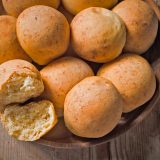Beatrice Franco Pinilla’s shop—really just a dark room cut into a whitewashed stone wall—is easily missed. Its only sign, tiny and hanging askew, doesn’t even say her shop’s name—El Rancho—you have to ask her for that. But for the residents of Villa de Leyva, a remote Colombian village that has changed little in its 400 years, that sign says all they need to know.
“Fábrica de almojábanas, arepas y empanadas.” That is, “Bakery of almojábanas, arepas and empanadas.”
The inside of Pinilla’s shop is just as unassuming. Battered wooden shelves, cartons of eggs, glass bottles of iridescent sodas, crates of beer. Most shelves are bare, but that doesn’t deter customers, who file in for the same thing that brought me: Pinilla’s almojábanas, the region’s signature cheese bread.
The region—remote from Colombia’s traditional trade routes—is the hub of the country’s dairy industry, which explains almojábanas. When other ingredients are sparse, you use what you have. So here they developed a bread—crispy outside, pillowy and tender inside—made mostly from the local fresh cheeses.
Which puzzled me, even as I watched Pinilla prepare it. The back of her shop opens to a courtyard, a walled-in brick patio, the space populated by potted aloes and wandering chickens. Also, a massive stone wood-fired oven she had built 25 years ago. Before that, she baked on a stone set over hot coals.
“My mother used to live in the country, and she would make these for the family and she would sell them,” Pinilla tells me as she gathers ingredients for almojábanas, including cheese delivered from a farm just 30 minutes before. “I learned from her and decided to open a business in town.”
She’s been at it some 50 years, supporting her family who live just off that same courtyard. With practiced ease, Pinilla dumps 5 pounds of cuajada cheese into a large bowl. It resembles a dry ricotta, but has a bit of mozzarella-like spring to the bite. To that, she adds a bit of salt and a bare pound of white cornmeal, a seemingly impossible ratio.
The dough comes together quickly as she works it with her hands, eventually tearing off small chunks, shaping them into buns and arranging 40 or more over massive, battered baking sheets. She checks the oven temperature simply by looking inside it, so close is their decades-old relationship.
When the buns emerged from the oven, the result was shocking. Sweet with corn and richly cheesy, yet light. The interior was airy, with the barest hint of molten cheese. The buns had an open crumb; some bites felt almost pleasantly airy. The bottoms had a cheesy crisp crunch.
It was some of the best bread I’ve tasted. And it’s in danger of being forgotten. She’s one of the few bakers left in the region making them the original way. “The tradition will die here,” she says. “My son sometimes helps me, he will light the fire. But young people don’t want to do this. It’s time-
consuming and hard.”
Perhaps as a business. But as I eat my fourth almojábana, there is no doubt. Whatever effort—and for the home cook, it isn’t much—this delicious result is well worth it.
Colombian Cheese Bread: Crispy, Tender, Savory and Sweet
The best bread is made from little more than cheese and cornmeal








